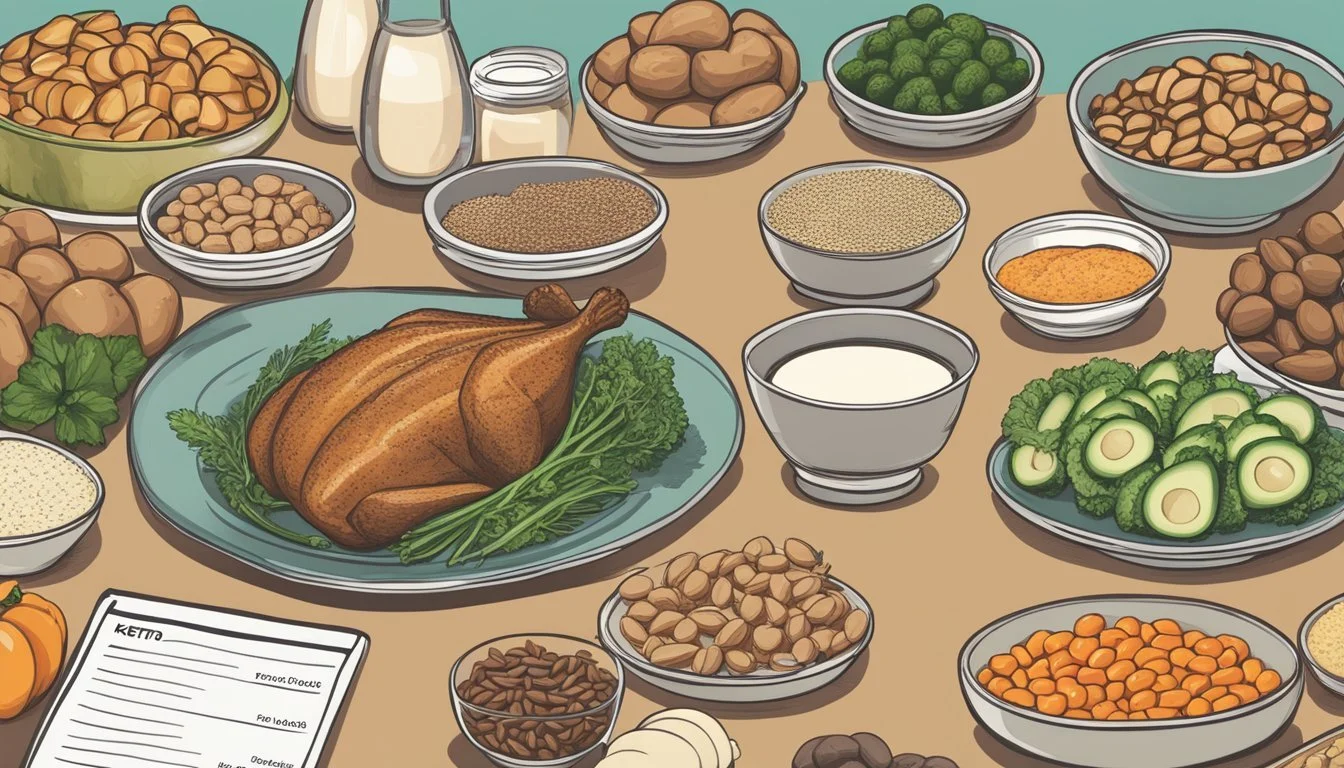Keto Diet and FODMAPs
Integrating Low-Carb and Digestive Health Strategies
The ketogenic diet, commonly known as keto, is a high-fat, low-carbohydrate eating plan that has gained popularity for weight loss and health benefits. It focuses on fat as the primary energy source, aiming to induce a state of ketosis where the body efficiently burns fat for fuel. On the other hand, the term FODMAP stands for fermentable oligosaccharides, disaccharides, monosaccharides, and polyols. These are short-chain carbohydrates that are poorly absorbed in the small intestine and can cause digestive discomfort in some individuals.
Combining a ketogenic diet with the principles of low-FODMAP eating can be a strategic approach for individuals seeking to address gastrointestinal issues such as bloating, gas, and irritable bowel syndrome (IBS) while still enjoying the metabolic benefits of ketosis. The low-FODMAP diet specifically targets the elimination of certain foods that can trigger digestive symptoms, which can complement the restricted carbohydrate intake of the keto diet. This tailored dietary approach is designed to minimize common digestive irritants without compromising the nutritional and metabolic advantages of ketosis.
Choosing the right foods while adhering to both ketogenic and low-FODMAP principles can be challenging but manageable. Many high-fat, low-carb foods naturally fit within a low-FODMAP framework, including certain meats, fish, eggs, and specific types of dairy, nuts, and seeds. The key to success lies in careful planning and being aware of food choices that meet the criteria for both diets simultaneously, allowing individuals to optimize their health outcomes while mitigating digestive discomfort.
Understanding Keto Diet
The ketogenic diet is a nutritional approach centered on high fat, moderate protein, and low carbohydrate intake to induce a metabolic state called ketosis.
Core Principles of Keto Diet
The ketogenic diet operates on the principle that by drastically reducing carbohydrate intake and replacing it with fat, the body enters a metabolic state called ketosis. In ketosis, the body becomes efficient at burning fat for energy instead of carbohydrates. Protein intake should be moderate, as excessively high protein can lead to less production of ketones.
Benefits of a Ketogenic Lifestyle
Adherents of the ketogenic diet often report a variety of benefits including weight loss, improved blood sugar control, and a decrease in appetite. Some individuals also experience an increase in mental clarity and energy levels. It's important to note that the benefits can vary from person to person.
Common Keto-Friendly Foods
A typical ketogenic diet is rich in fats which can include foods like:
Meats: steak, ground beef, chicken, pork, and bacon
Fish: particularly fatty fish like salmon
Oils: coconut oil, olive oil, and avocado oil
Eggs, high-fat dairy, nuts, and seeds are also integral to the diet.
Carbohydrates are limited to about 20-50 grams per day to maintain ketosis.
Potential Risks and Considerations
While the ketogenic diet can offer benefits, potential risks and considerations include flu-like symptoms known as the "keto flu", elevated cholesterol, and nutrient deficiencies. It's also possible to experience digestive issues like diarrhea, constipation, and bloating. Individuals should consult with healthcare professionals before beginning any new diet, especially one as strict as the ketogenic diet.
Understanding FODMAPs
In exploring the relationship between diet and digestive health, FODMAPs play a significant role, particularly for those with sensitive guts. This section will provide a foundational understanding of what FODMAPs are, how they can affect digestive symptoms, identify high and low FODMAP foods, and discuss the basics of managing a low-FODMAP diet.
Definition and Categories of FODMAPs
FODMAPs are Fermentable Oligosaccharides, Disaccharides, Monosaccharides, and Polyols, which are short-chain carbohydrates that are poorly absorbed in the small intestine. They can be categorized as follows:
Oligosaccharides: Include fructans and galacto-oligosaccharides (GOS).
Disaccharides: Primarily lactose.
Monosaccharides: Mainly fructose when in excess of glucose.
Polyols: Sugar alcohols like sorbitol and mannitol.
FODMAPs and Digestive Symptoms
For individuals with a sensitive gut, FODMAPs can elevate digestive symptoms because they are osmotically active, meaning they pull water into the intestine, and fermented by gut bacteria, producing gas. The common symptoms include bloating, gas, and abdominal pain. People with irritable bowel syndrome (IBS) may find that a gastroenterologist recommends a low-FODMAP diet to identify and manage their triggers.
High and Low FODMAP Foods
High FODMAP foods are rich in fermentable carbohydrates and include items such as:
Fruits like apples and blackberries
Dairy products high in lactose
Wheat and other grains with fructans
Legumes and pulses
Conversely, low FODMAP foods are better tolerated and include:
Grains like rice and oats
Lactose-free dairy or alternatives
Vegetables such as carrots and cucumbers
Firm fruits like oranges and unripe bananas
Managing a Low-FODMAP Diet
Starting a low-FODMAP diet typically involves the following steps:
Elimination: Remove high FODMAP foods from the diet for a period, often 4-6 weeks.
Reintroduction: Gradually reintroduce foods one at a time to identify triggers.
Personalization: Develop a long-term diet that minimizes symptoms while ensuring nutritional adequacy.
Consultation with a dietitian experienced in FODMAPs can provide support and ensure the diet is followed safely and effectively.
Comparing Keto and FODMAP Diets
Investigating Keto and FODMAP diets reveals stark differences in objectives and food choices, as well as ways these diets might work together for specific health conditions.
Differences in Dietary Approach
The ketogenic (keto) diet is characterized by its high-fat, moderate-protein, and extremely low-carbohydrate approach. Its aim is to induce ketosis, a metabolic state where the body burns fat instead of carbohydrates for energy. In contrast, the Low FODMAP diet targets the reduction of certain carbohydrates, known as FODMAPs (Fermentable Oligo-, Di-, Mono-saccharides And Polyols), which are implicated in exacerbating symptoms of Irritable Bowel Syndrome (IBS) and other gut health issues. This diet is not concerned with macronutrient ratios or fat intake.
Potential Conflicts and Compatibilities
Compatibility between the keto and Low FODMAP diets may occur since both restrict high-carbohydrate foods. However, keto emphasizes fats, including dairy and avocados, which may be high in FODMAPs. This creates potential conflict for individuals trying to combine these nutritional plans. Adapting a diet plan that is both keto and low in FODMAPs involves meticulous food selection to avoid ingredients that could trigger digestive discomfort.
Suitability for IBS and Gut Health
The Low FODMAP diet is specifically designed to alleviate symptoms of IBS by removing known irritants from the diet. It has shown efficacy in improving gut health. Conversely, the traditional keto diet does not specifically target gut bacteria or disorders like IBS but can reduce sugar intake, which may indirectly benefit gut flora. Careful modifications and professional guidance are necessary to ensure a keto diet is suitable for those with IBS.
Individualizing Your Nutrition Plan
Individual responses to both keto and Low FODMAP diets can differ. Personalization is key: what works for one person may not work for another. Both diets could potentially reduce inflammation or improve gut health, depending on how they are implemented and whether they align with an individual's unique digestive and metabolic needs. Consultation with a healthcare provider is recommended to tailor a nutrition plan specific to one's health goals and medical conditions.
Implementing a Keto-FODMAP Approach
The Keto-FODMAP approach requires meticulous food selection and awareness of how food affects individual health. Accurate meal planning along with ongoing monitoring are essential steps in combining these dietary strategies effectively.
Food Selection and Meal Planning
They must choose foods that are both low in carbohydrates and low in FODMAPs to maintain ketosis while managing digestive sensitivities. For example, meat, eggs, and certain cheeses are keto-friendly and also typically low in FODMAPs. Careful reading of ingredient labels is crucial as many processed foods contain high-FODMAP additives like inulin or sorbitol. Meal planning may involve preparing homemade meals and recipes to ensure compatibility with both diets.
Vegetables: Opt for spinach, zucchini, and tomatoes.
Fruits: Limit to small servings of berries.
Dairy: Choose lactose-free options where possible.
Nuts: Almonds and peanuts in moderation are generally safe.
Strategies for Success
They should start with a structured plan, possibly designed by a dietitian, to outline the appropriate foods and recipes that fit within the parameters of Keto and low FODMAP. Consistency is key; thus, maintaining a food diary can be greatly beneficial. It helps to identify how specific foods may impact their symptoms and well-being.
Prepare Ahead: Batch cook meals that align with both diets.
Educate Yourself: Understand the components of both diets.
Monitoring and Adjusting Your Diet
Regular monitoring is required to ensure that their nutritional intake meets their health goals without exacerbating digestive issues. They can keep track of symptoms, ketone levels, and overall wellbeing. Based on this data, they may need to adjust meal plans and food choices. A gastroenterologist or keto-informed doctor can provide medical advice when necessary to fine-tune the diet.
Symptom Tracking: Log digestive changes and discomfort.
Ketone Testing: Use strips or a meter to ensure ketosis.
Role of Health Professionals
Assistance from health professionals is vital. A dietitian skilled in both ketogenic and low FODMAP diets can offer tailored advice and recipes, while a doctor or gastroenterologist can oversee health outcomes and medical concerns. Professional guidance ensures a safe and effective implementation of the Keto-FODMAP diet.
Consult Regularly: Check-ins with healthcare providers.
Expert Resources: Use expert-constructed food lists and meal plans.
Impact on Digestive Health
This section examines how the ketogenic diet and FODMAPs influence digestive health through various mechanisms, including the potential triggers of digestive symptoms, their relationship with prebiotic and probiotic elements, effects on the gut microbiota, and the management of inflammation and digestive distress.
Digestive Symptoms and Food Triggers
Individuals with irritable bowel syndrome (IBS) often experience a reduction in digestive symptoms such as constipation, diarrhea, and abdominal pain when following a low-FODMAP diet. Conversely, a ketogenic diet, which is low in carbohydrates and high in fats, can sometimes alleviate symptoms by eliminating common irritants found in higher-carb diets.
The Role of Prebiotics and Probiotics
Prebiotics are dietary fibers that feed the beneficial bacteria in the gut, known as probiotics. However, a ketogenic diet can be low in these fibers, potentially affecting the gut microbiome. In contrast, a diet high in FODMAPs provides ample prebiotics but can exacerbate IBS symptoms in sensitive individuals.
Influence on Gut Microbiome
Studies suggest that adherence to a ketogenic diet may lead to a reduction in Bifidobacterium, a beneficial gut bacterium, and a decrease in Firmicutes which are butyrate-producing bacteria important for gut health. Adjusting to a low-FODMAP regimen can alter the gut microbiome composition, often reducing inflammation and easing IBS symptoms.
Managing Inflammation and Distress
Both ketogenic and low-FODMAP diets can play a role in managing digestive inflammation. A ketogenic diet may decrease inflammation by altering fuel sources and reducing insulin spikes, while a low-FODMAP diet minimizes the fermentation that can lead to increased gut inflammation. They both offer different mechanisms for individuals to manage their digestive distress effectively.
Nutritional Considerations
In pursuing a Keto diet low in FODMAPs, one must focus on both macronutrient ratios and the quality of micronutrients to maintain overall health and digestive comfort.
Balancing Macronutrients and Micronutrients
A keto diet typically consists of high fat, moderate protein, and very low carbohydrate intake. It is essential to monitor the balance of 70% fat, 20% protein, and 10% carbohydrates to maintain ketosis. On the micronutrient side, individuals should ensure they receive adequate vitamins and minerals from low-FODMAP sources to compensate for restrictions on certain fruits, vegetables, and whole grains.
Ensuring Adequate Fiber Intake
While adhering to a keto and low-FODMAP diet, one might struggle with fiber intake due to the limitation on certain fruits, grains, and legumes. To mitigate this, they should incorporate foods like:
Chia seeds
Flaxseeds
Spinach
Squash
These sources provide fiber while respecting the principles of both dietary approaches.
Importance of Hydration
Hydration is critical, especially on a keto diet as it helps to prevent common side effects such as constipation and the "keto flu". Individuals should aim to consume ample water—generally, a minimum of 8 cups (64 ounces) per day, though needs may vary based on activity level and other factors.
Supplementation and Dietary Adjustments
To combat potential nutritional deficiencies, supplementation may be required. Common supplements for those on a restrictive diet include:
Magnesium
Sodium
Potassium
Vitamin D
Before starting any supplementation, it is recommended to consult with a healthcare provider. Additionally, dietary adjustments should be made based on individual reactions to specific low-FODMAP keto-compliant foods to maintain optimal digestive health.
Challenges and Solutions
Navigating a diet that combines the ketogenic approach with low FODMAP principles can present several challenges and requires strategic solutions. Each phase of this dietary plan demands attention to detail and dedication.
Overcoming Restriction and Reintroduction Phases
The restriction phase of a low FODMAP diet temporarily eliminates foods that may cause digestive distress. When combined with keto, which restricts carbohydrate intake, this can narrow food choices significantly. To overcome this, individuals should create a detailed meal plan that includes keto-friendly, low FODMAP options and adhere to it strictly. During reintroduction, introducing one food at a time while monitoring symptoms can help identify specific triggers.
Solutions:
Create a meal plan: Chart out all meals and snacks that fit both keto and low FODMAP criteria.
Monitor closely: Track symptoms to identify foods that can be successfully reintroduced without issues.
Dealing with Social Situations and Stress
Social situations can be challenging as they often present limited dietary options. It's important for individuals to plan ahead by checking restaurant menus or bringing their own food to events. Managing stress, which can exacerbate gastrointestinal symptoms, is also crucial. Techniques such as deep breathing exercises and mindfulness can help mitigate stress-related digestive issues.
Tips:
Check menus ahead: Look for keto and low FODMAP options before attending social events.
Mindfulness: Regular practice can help reduce stress that may trigger symptoms.
Finding Support and Resources
Garnering support from friends, family, or a healthcare professional is vital. They can offer encouragement and help adapt recipes to fit dietary needs. Online communities also serve as an excellent resource where individuals can share experiences, recipes, and coping strategies.
Support Networks:
Healthcare Professional: Regular consultations to guide dietary choices and troubleshoot issues.
Online Communities: Forums and social media groups dedicated to the keto and low FODMAP lifestyles.
Adapting to Lifestyle Changes
Adhering to a strict diet, especially one that combines two restrictive eating patterns, requires significant lifestyle adjustments. Individuals should set realistic goals and expect a period of adaptation. Prioritizing meal prep and learning to read food labels with scrutiny are key steps in managing the dietary changes.
Adaptation Strategies:
Set realistic goals: Understand that adapting to dietary changes is a process that takes time and patience.
Learn to read labels: Become proficient in identifying high FODMAP and high carb ingredients to avoid.






